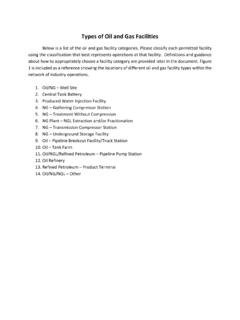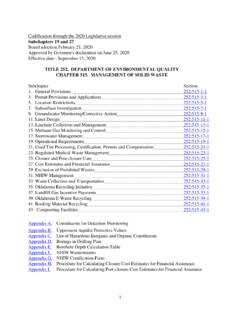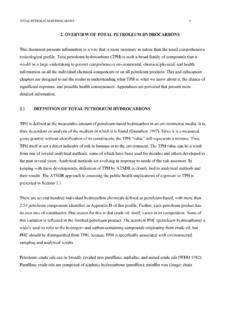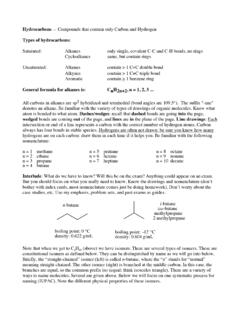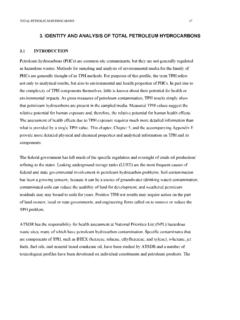Transcription of Risk-Based Levels for Total Petroleum Hydrocarbons (TPH)
1 Risk-Based Levels for Total Petroleum Hydrocarbons (TPH) Total Petroleum Hydrocarbons (TPH) is typically defined as carbon chains in the range of C6 through C35. Products containing TPH include a wide variety of mixtures that may contain hundreds to thousands of hydrocarbon compounds including aliphatic (straight carbon chain) and aromatic (benzene ring) guidance is specific to the analysis and development of cleanup Levels for TPH and is intended to be used for cleanups at sites where volatile organic compounds (VOCs), semi-volatile organic compounds (SVOCs), and metals, have been screened out or are also being fully evaluated.
2 If additional chemicals such as polychlorinated biphenyls (PCBs) or pesticides are suspected, they may also need to be evaluated. Since individual chemicals and metals have specific toxicity information, TPH can be addressed once the underlying chemicals and metals have been screened s Risk Team should be contacted prior to initiating a cleanup under this guidance, if anything other than the Tier 1 Residential level is used. The Team may be reached at (405) of refined product spills fall under DEQ s Diesel and Gasoline Spills RangesDEQ defines three ranges of TPH, although there is often overlap between the ranges from each individual source ( refined gasoline or diesel).
3 Gasoline range(GRO) >C6-C12 Diesel range(DRO) >C13-C28 Lube oil range>C28-C35In the past, TPH was reported as a single overall number. However, analyses are now generally reported as TPH in the various ranges in which they Methods1To ensure consistent data quality, DEQ requires data from laboratories that are recognized by the State of Oklahoma laboratory accreditation program, or equivalent. DEQ-accredited labs may be found at Texas Commission on Environmental Quality (TCEQ) analytical methods discussed in this guidance may be found at publication is issued by the Oklahoma Department of Environmental Quality authorized by Scott A.
4 Thompson, Executive Director. Copies have been prepared at a cost of $ each. Copies have been deposited with the publications clearinghouse of the Oklahoma Department of Libraries. (Fact Sheets\LPD\Risk Based Levels 2/2022) Risk-Based Levels for Total Petroleum Hydrocarbons (TPH) DEQ recommends TCEQ Method 1005 for preliminary characterization of soil and groundwater. Other methods that cover similar ranges may be used; however, use of methods other than TCEQ Method 1005 should be discussed with the DEQ Risk Team prior to use. All TCEQ Method 1005 TPH analyses should be conducted without the use of a silica gel or similar clean up method.
5 For all analyses, ensure that the chosen laboratory is able to reach adequate quantitation LevelsDEQ uses three Tiers of TPH cleanup Levels , based upon either protection of groundwater or the relative toxicity of the hydrocarbon 1 is a generic cleanup level applicable to residential scenarios, and is based on protection of 2 represents cleanup Levels for each of the three TPH ranges for both residential and industrial scenarios. Levels are based on the relative toxicity of the hydrocarbon 3 is a site-specific scenario and includes use of TCEQ Method 1006 to determine which aliphatic or aromatic fractions are three Tiers assume other priority pollutants have been evaluated.
6 If other contaminants are present, you will need to discuss with DEQ s Risk Team to determine the correct approach for determining Total risk present at the site. Use of any level beyond Tier 1 Residential is considered a Risk-Based remediation. For DEQ approval of a Risk-Based remediation, groundwater investigation and monitoring, and a deed notice may be 2 and 3 cleanups may require temporary or permanent monitoring well installation as part of the investigation. Since dilution and attenuation vary depending on soil type, site lithology, and other site-specific parameters, coordination with DEQ s Risk Team will be needed to ensure the cleanup level is protective of groundwater.
7 Prior to developing Tier 3 site-specific cleanup Levels , please contact DEQ s Risk Team for approval of all assumptions and inputs made for site-specific determinations. Tier 1 Tier 1 Generic Cleanup LevelsGround mg/L50 mg/kgTier 2 Generic Cleanup LevelsGround water (mg/L)Soil (mg/kg)RESIDENTIALGRO (C6-C12) DRO (C12-28) Lube Oil (>C28-35)* 400 1,800 INDUSTRIALGRO (C6-C12) DRO (C12-28) Lube Oil (>C28-35)* ,500 2,610 23,000* Total of all the Levels for Total Petroleum Hydrocarbons (TPH) Tier 3 Site Specific1. Initial TPH analysis should be TCEQ Method 1005 and be conducted without the use of a silica gel or similar clean up Determine the specific fractions of TPH present, aliphatic and aromatic, using TCEQ Method 1006.
8 Analysis should be conducted on samples with greater impacts, as determined by TCEQ Method 1005 Consult with DEQ s Risk Team at (405) 702-5100 to determine appropriate Tier 3 cleanup


